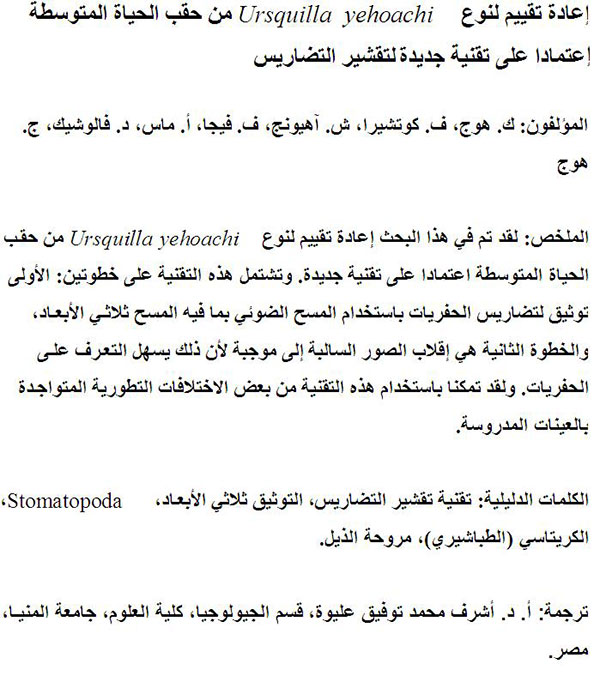Re-evaluation of the Mesozoic mantis shrimp Ursquilla yehoachi based on new material and the virtual peel technique
Carolin Haug, Verena Kutschera, Shane T. Ahyong, Francisco J. Vega, Andreas Maas, Dieter Waloszek, and Joachim T. Haug
Plain Language Abstract
The find of a new well-preserved specimen of a fossil mantis shrimp, Ursquilla yehoachi, from the Upper Cretaceous (ca. 75 million years old), led us to compare it with the original four specimens and to re-evaluate this species using the new data. All five specimens were documented with a new technique, which is introduced here and termed virtual peel technique. This technique includes two steps: 1) The fossils have a low relief, so it is possible to document their three-dimensional surface; this is done with a standard flat-bed scanner. 2) The originally negative relief of the fossils documented with the flat-bed scanner is inverted on the computer; the resulting positive relief allows a better understanding of the fossil. In contrast to the original four specimens, the new specimen of Ursquilla yehoachi has the last pair of legs (= uropods), especially the outer ramus (= exopod) preserved. This is an important feature for the internal relationships of mantis shrimps (stomatopods). Direct comparison of this outer leg ramus with that of modern mantis shrimps reveals striking similarities: In living mantis shrimps and in Ursquilla yehoachi the uropodal exopod has two elements; the distal one of these elements is paddle-shaped. This supports earlier assumptions that Ursquilla yehoachi is a relatively modern mantis shrimp, more exactly belongs to Squilloidea. The reason of observable variation among the available specimens of Ursquilla yehoachi is interpreted in a way that the specimens are representatives of different growth stages, and the body proportions change at different growth rates (allometric growth). We present this effect on the telson, which is the last part of the body and forms the tail fan together with the last pair of legs. The telson in Ursquilla yehoachi becomes relatively broader with increasing size.
Resumen en Español
Re-evaluación del camarón mantis mesozóico Ursquilla yehoachi, con base en nuevo material y en la técnica de peel virual.
Re-evaluamos el camarón mantis mesozóico Ursquilla yehoachi, con base en los cuatro ejemplares originales y uno nuevo, exquisitamente preservado. Todos los ejemplares fueron documentados mediante la aplicación de una nueva técnica, que es aquí presentada y denominada técnica del peel virtual. Esta técnica incluye dos pasos: 1) Documentación de fósiles de bajo relieve, incluyendo su información 3D con la ayuda de un escáner estándar plano. 2) Inversión virtual del relieve negativo de los fósiles; el relieve positivo resultante facilita una mejor comprensión del fósil. A diferencia de los ejemplares previamente conocidos, el nuevo ejemplar de U. yehoachi preserva la mayoría de los detalles del urópodo, incluyendo el exópodo, un carácter importante en la filogenia de los estomatópodos. De manera notable, éste exópodo tiene importantes similitudes con el de los estomatópodos modernos, ya que es bipartita y posee una porción distal en forma de remo, apoyando inferencias previas sobre la posición sistemática de U. yehoachi dentro de los Squilloidea. Las diferencias morfológicas que se observan entre el material disponible de U. yehoachi pueden ahora ser identificadas como variación ontogénica. El telson, por ejemplo, adquiere una forma proporcionalmente más amplia conforme se incrementa el tamaño, un resultado del crecimiento alométrico.
Palabras clave: técnica de peel virtual; documentación de tercera dimensión; Stomatopoda; Cretácico; abanico caudal.
Traducción: Authors
Résumé en Français
Révision de la crevette-mante mésozoïque Ursquilla yehoachi sur la base de matériel nouveau et d'une technique de décorticage virtuel
Nous révision la crevette-mante mésozoïque Ursquilla yehoachi, sur la base des quatre spécimens originaux et d'un nouveau magnifiquement préservé. Tous les spécimens on été étudiés par l'application d'une nouvelle technique que nous présentons ici et nommée technique de décorticage virtuel. Cette technique comprend deux étapes : 1) étude des fossiles à relief modéré, incluant les informations 3D, à l'aide d'un scanner standard plat. 2) inversion virtuelle du relief négatif du fossile ; le relief positif obtenu permettant une meilleur compréhension du fossile. Contrairement aux autres spécimens précédemment connus, le nouveau spécimen de U. yehoachi a préservé la plupart des détails de l'uropode, incluant l'exopode, un caractère important dans la phylogénie des stomatopodes. Remarquablement, cet exopode montre des similarités frappantes avec ceux des stomatopodes modernes, étant biparti et ayant une partie distale en forme de pagaie, supportant les hypothèses précédentes concernant la place systématique de U. yehoachi au sein des Squilloidea. Les différences morphologiques observables parmi le matériel d' U. yehoachi disponible peuvent maintenant être identifiées comme des variations ontogénétiques. Le telson, par exemple, acquière une forme proportionnellement plus large quand la taille augmente, le résultat d'une croissance allométrique.
Mots clés: technique de décorticage virtuel; étude 3D; Stomatopoda; Crétacé; queue en éventail
Translator: Olivier Maridet
Deutsche Zusammenfassung
Neue Betrachtung des mesozoischen Fangschreckenkrebses Ursquilla yehoachi auf der Grundlage neuen Materials und der virtuellen Abguss-Technik
Neuuntersuchungen des mesozoischen Fangschreckenkrebses Ursquilla yehoachi wurden durchgeführt an den vier ursprünglichen Stücken und einem neuen, besonders gut erhaltenem Exemplar. Alle Stücke wurden mit Hilfe einer neuen Technik dokumentiert, der 'virtuellen Abguss'-Technik. Die Technik umfasst zwei Schritte: 1) Die Dokumentation von Fossilien mit flachem Relief einschließlich ihrer 3D-Information mit Hilfe eines gewöhnlichen Flachbettscanners. 2) Die virtuelle Tiefenumkehr des negativen Reliefs der Fossilien; das resultierende positive Relief erleichtert das Verständnis des Fossils. Im Gegensatz zu den bisher bekannten Exemplaren sind am neuen Stück von U. yehoachi die meisten Details des Uropoden einschließlich des Exopoditen erhalten, welcher ein wichtiges Merkmal für die Stomatopodenphylogenie darstellt. Dieser Exopodit weist starke Ähnlichkeit mit dem moderner Stomatopoden auf; er ist zweiteilig und besitzt einen paddelförmigen distalen Teil. Dadurch werden frühere Annahmen zur systematischen Stellung von U. yehoachi innerhalb der Squilloidea untermauert. Die morphologischen Unterschiede zwischen den verschiedenen bekannten Stücken von U. yehoachi können nun durch ontogenetische Variation erklärt werden. Das Telson beispielsweise wird mit wachsender Größe verhältnismäßig breiter, eine Folge allometrischen Wachstums.
Schlüsselwörter: virtuelle Abguss-Technik; dreidimensionale Dokumentation; Stomatopoda; Kreide; Schwanzfächer
Translator: Authors
Arabic

Translator: Ashraf M.T. Elewa

